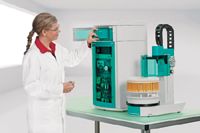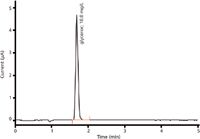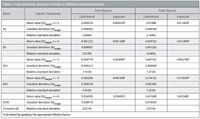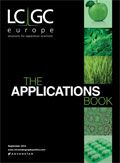Glycerol Determination in Biodiesel and Biodiesel Blends According to ASTM D 7591
Metrohm
The presented ion chromatographic (IC) method is applicable to all biodiesel types and blends. Before chromatographic separation, free glycerol and bound glycerol are isolated by a straightforward extraction and saponification-extraction technique. Pulsed amperometric detection (PAD) following chromatographic separation achieves an outstanding method detection limit (MDL) of 0.5 ppm by mass for glycerol and therefore easily fulfills ASTM and EN performance specifications. The described method fully complies with ASTM D 7591.
Biodiesel
The four primary driving forces behind the biofuel boom are the world's increasing thirst for petroleum (80 Mbarrels/day), the diminishing supply of fossil fuels, global warming, and the intention to reduce the dependence on fuel imports. In addition, most biofuels are produced by straightforward manufacturing processes, are readily biodegradable and non-toxic, have low emission profiles, and can be used as is or blended with conventional fuels.
Biodiesel is produced by transesterifying the triglycerides in the parent oil or fat with an alcohol, usually methanol, in the presence of a catalyst (base, acid, or enzyme) to yield fatty acid methyl esters (FAME) and free glycerol as coproduct (Figure 1). As reaction rates under acid or enzyme catalysis are relatively slow, most producers use the rapid alkali-catalyzed transesterification.

Figure 1: Base-catalyzed transesterification of a triglyceride with methanol.
An incomplete reaction leads to the formation of residual glycerol intermediates such as mono-, di-, and triacylglycerides (bonded glycerols). In contrast, complete conversion results in the formation of highly water-soluble glycerol (free glycerol). The latter is separated from the final product at the end of the production process. However, traces of glycerol are frequently found in the ester phase. Both free and bonded glycerols (= total glycerol) lead to severe operational problems such as injector and valve deposits or filter clogging. Accordingly, the US ASTM D 6751 (1) specifies a maximum total glycerol content of 2400 ppm (0.24%), while the European EN 14214 (2) stipulates 2500 ppm (0.25%). In both standards, the free glycerol content is limited to 200 ppm (0.02%).
Based on the analysis of biodiesel blends made from coconut oil, this article demonstrates sensitive analysis of the free and total glycerol content via simple and innovative ion chromatography (IC) followed by pulsed amperometric detection (PAD) according to ASTM D 7591 (3).
Experimental
Instrumentation
The chromatography system consisted of the 850 Professional IC with Amperometric Detector and the 858 Professional Sample Processor (all Metrohm AG, Figure 2). For all separations, a Metrosep Carb 1 - 150/4.0 anion-exchange column was used with a flow rate of 1 mL/min. The injection valve was fitted with a 20 μL injection loop and separation was achieved by isocratic elution employing a 100 mmol/L NaOH eluent.

Figure 2: 850 Professional IC with IC Amperometric Detector and 858 Professional Sample Processor.
The amperometric detector consists of a gold working electrode in combination with a solid-phase reference electrode and a stainless-steel auxiliary electrode. A triple-step potential waveform was applied.
Instrument control, data acquisition, and processing were performed using MagIC Net software (Metrohm).
Reagents
Glycerol standard and potassium hydroxide were reagent grade. They were purchased from Sigma-Aldrich (Milwaukee, Wisconsin, USA). Synthetic biodiesel blends B2 to B20 were produced by the mixing of biodiesel made from glycerol-containing coconut-oil and low-sulphur petroleum diesel, respectively. All standard solutions and eluents were prepared from deionized water with a specific resistance higher than 18 MΩ·cm.

Figure 3: Glycerol determination using pulsed amperometric detection.
Extraction and Saponification
While the extraction of free glycerol can be performed by a simple separating funnel, saponification-extraction for bound glycerol requires a commercially available reflux system capable of heating the reaction mixture to 90 °C.

Figure 4: PAD chromatogram with (a) free and (b) total glycerol peaks in a B2 blend.
(a) Free Glycerol
Generally, a high free glycerol content points to incomplete separation of the ester and glycerol phase. Because of the high water solubility of the triol — 1000 mg and more will dissolve in a litre of water — free glycerol can be readily extracted from biodiesel or biodiesel blends.
The procedure comprises the addition of 45 g of distilled water to approximately 5 g of sample. After vigorous shaking for 5 min, the sample is allowed to stand for another 5 min. After phase separation, an aliquot of the aqueous phase is filled into a chromatography vial and placed on the Sample Processor for analysis.
(b) Total Glycerol
Total glycerol is the sum of free and bound glycerol. The latter is the sum of residual mono-, di-, and triglycerides and stems from incomplete esterification reactions. Glycerides are removed from the organic phase by saponification reaction with sodium hydroxide and subsequent extraction of the generated glycerol with water.
In a reflux system, 20 mL of 0.01 mol/L potassium hydroxide is added to approximately 2 g of sample. The mixture is heated to reflux for 1 h. After cooling to room temperature, the volume of the mixture is made up to 50 mL. The released glycerol is then extracted into the aqueous phase according to the procedure described above.
Results
Calibration and Method Detection Limit
Calibration standards range from 0.5 mg/L to 100 mg/L. Calibration is linear providing a correlation coefficient of 0.99996 with a relative standard deviation better than 0.437%.
The detection limit was determined by a 15-fold injection of a 0.5 ppm glycerol standard. The excellent method detection limit (MDL) of 0.5 ppm glycerol by mass (0.7·10–4 %) exceeds by far the maximum free glycerol content of 200 ppm (0.02%) required by the ASTM D 6751 or EN 14214.
Free and Total Glycerol Content in Different Biodiesel Blends and a Coconut-oil Biodiesel Sample
While the total glycerol limit in ASTM D 6157 and EN 14214 is 0.24% and 0.25%, respectively, the allowed maximum content of free glycerol is only 0.02% in both standards. The pure biodiesel sample B100 contains 0.027% of free and 0.62% of total glycerol (Table 1) and therefore exceeds the limits stipulated by the two standards. Before being used as a fuel or being blended with petroleum diesel, the coconut methyl ester first has to be freed of its excess glyceride and glycerol contents.

Figure 5: Stacked PAD chromatograms of different biodiesel blends (B2â¦B20).
According to Table 1 and Figure 4 the free and total glycerol contents in all investigated biodiesel blends B2 to B20 are below 0.0051% and 0.124%.

Table 1: Free and total glycerol content in different biodiesel blends.
Conclusion
Free and bound glycerol is determined by IC and subsequent PAD in accordance with ASTM D 7591. It is a simple, cost-effective, and very accurate method that includes a straightforward extraction and saponification-extraction for determining the free and bound glycerol content, respectively. With an MDL of 0.5 ppm by mass for total glycerol, IC–PAD easily exceeds the requirements of ASTM and DIN standards.
References
(1) ASTM D 6751, Standard specification for biodiesel fuel blend stock (B100) for middle distillate fuels.
(2) DIN 14214, Automotive fuels — fatty acid methyl esters (FAME) for diesel engines — requirements and test methods.
(3) ASTM D 7591, Standard test method for determination of free and total glycerin in biodiesel blends by anion exchange chromatography.

Metrohm International Headquarters
Ionenstrasse, 9101 Herisau, Switzerland
Tel: +41 71 353 85 04
Website: www.metrohm.com

Regulatory Deadlines and Supply Chain Challenges Take Center Stage in Nitrosamine Discussion
April 10th 2025During an LCGC International peer exchange, Aloka Srinivasan, Mayank Bhanti, and Amber Burch discussed the regulatory deadlines and supply chain challenges that come with nitrosamine analysis.



















